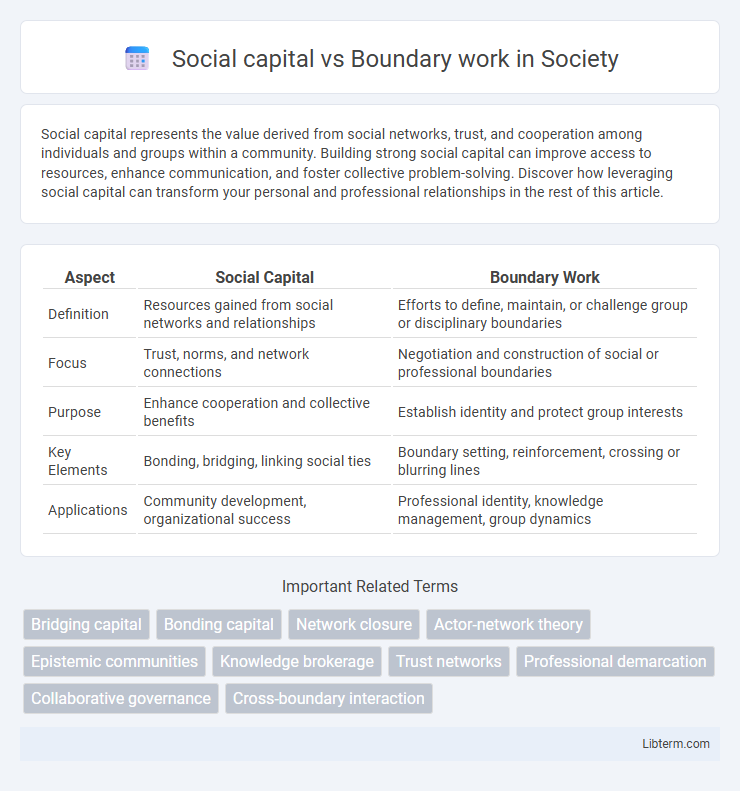Social capital represents the value derived from social networks, trust, and cooperation among individuals and groups within a community. Building strong social capital can improve access to resources, enhance communication, and foster collective problem-solving. Discover how leveraging social capital can transform your personal and professional relationships in the rest of this article.
Table of Comparison
| Aspect | Social Capital | Boundary Work |
|---|---|---|
| Definition | Resources gained from social networks and relationships | Efforts to define, maintain, or challenge group or disciplinary boundaries |
| Focus | Trust, norms, and network connections | Negotiation and construction of social or professional boundaries |
| Purpose | Enhance cooperation and collective benefits | Establish identity and protect group interests |
| Key Elements | Bonding, bridging, linking social ties | Boundary setting, reinforcement, crossing or blurring lines |
| Applications | Community development, organizational success | Professional identity, knowledge management, group dynamics |
Understanding Social Capital: Key Concepts
Social capital refers to the networks, norms, and trust that facilitate coordination and cooperation among individuals or groups for mutual benefit. It encompasses bonding social capital, which strengthens ties within homogenous groups, and bridging social capital, which connects diverse communities, enhancing access to resources and information. Understanding social capital is crucial for analyzing how relationships and social structures influence economic outcomes, community development, and knowledge sharing.
Defining Boundary Work in Social Contexts
Boundary work in social contexts refers to the process through which individuals or groups create, maintain, or challenge divisions between social categories, identities, or domains of knowledge. This practice shapes social interactions by delineating who belongs to specific communities and who does not, influencing access to resources and social capital. By negotiating boundaries, actors manage social inclusion and exclusion, impacting collaboration, trust, and the distribution of power within networks.
Historical Evolution of Social Capital Theory
Social capital theory has evolved from early sociological perspectives emphasizing networks, trust, and norms facilitating cooperation and resource exchange within communities. Boundary work explores the processes that define and maintain social group distinctions, influencing how social capital is accessed and mobilized across different social fields. The historical development of social capital theory highlights the interplay between social cohesion and boundary construction, shaping collective action and organizational dynamics.
The Role of Boundary Work in Group Dynamics
Boundary work plays a critical role in group dynamics by defining, negotiating, and maintaining group identities and social boundaries, which directly affects social capital formation and distribution. It involves the active construction of distinctions between in-groups and out-groups, facilitating trust, cooperation, and resource sharing within defined social networks. Effective boundary work enhances cohesion and collective action, enabling groups to leverage social capital for collective benefits while managing external pressures and interactions.
Comparing Functions: Social Capital vs Boundary Work
Social capital facilitates trust, cooperation, and resource exchange within and across social networks, enhancing collaborative efforts and knowledge sharing. Boundary work focuses on managing and negotiating the distinctions and interactions between different social or professional groups, ensuring clarity and coordination in overlapping domains. While social capital builds relational assets that enable collective action, boundary work structures these relationships to maintain identity and operational coherence across group boundaries.
Impact on Community Development
Social capital fosters trust and collaboration among community members, enhancing collective action and resource sharing crucial for sustainable community development. Boundary work facilitates cross-sector partnerships by bridging institutional divides, enabling diverse stakeholders to co-create innovative solutions addressing complex social issues. Both mechanisms significantly contribute to community resilience, with social capital strengthening internal cohesion and boundary work expanding external networks and resource access.
Case Studies: Practical Applications
Case studies in social capital and boundary work reveal practical applications across organizational and community settings where trust and relationships enhance collaboration. Social capital fosters networks that enable resource sharing and collective action, while boundary work negotiates differences across social or professional groups to facilitate knowledge exchange. These case studies demonstrate how integrating social capital with boundary work strategies improves problem-solving and innovation in diverse environments.
Intersections and Tensions Between the Two Theories
Social capital emphasizes the value of networks and relationships in facilitating cooperation and resource exchange, while boundary work focuses on the processes of defining and maintaining distinctions between groups or domains. Intersections occur as social capital relies on trust and shared norms that may be reinforced or contested through boundary work practices, creating dynamic social structures. Tensions emerge when boundary work restricts the free flow of social capital, limiting access and collaboration across group lines, yet can also strengthen internal group cohesion vital for mobilizing collective resources.
Measuring Social Capital and Boundary Work Outcomes
Measuring social capital involves quantifying networks, trust, and norms that facilitate cooperation within communities, often using tools like surveys, social network analysis, and indicators of civic participation. Boundary work outcomes are assessed by evaluating the effectiveness of knowledge exchange across institutional or disciplinary divides, focusing on collaboration quality, integration of diverse perspectives, and problem-solving capacity. Combining measures of social capital with boundary work outcomes provides insight into how relationships and trust shape interdisciplinary cooperation and innovation.
Future Directions in Research and Practice
Future research on social capital versus boundary work should explore the integration of digital platforms to enhance cross-sector collaboration and knowledge exchange. Emphasizing multidisciplinary approaches can uncover how social capital dynamics facilitate boundary spanning activities in organizational and community settings. Practitioners need to develop tools that leverage social networks to reduce friction in boundary work, promoting innovation and resilience in rapidly changing environments.
Social capital Infographic

 libterm.com
libterm.com